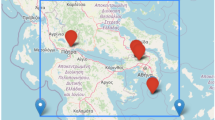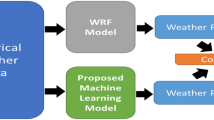Abstract
The prediction of wind in terms of both wind speed and direction, which has a crucial impact on many real-world applications like aviation and wind power generation, is extremely challenging due to the high stochasticity and complicated correlation in the weather data. Existing methods typically focus on a sub-set of influential factors and thus lack a systematic treatment of the problem. In addition, fine-grained forecasting is essential for efficient industry operations, but has been less attended in the literature. In this work, we propose a novel data-driven model, multi-horizon spatiotemporal network (MHSTN), generally for accurate and efficient fine-grained wind prediction. MHSTN integrates multiple deep neural networks targeting different factors in a sequence-to-sequence (Seq2Seq) backbone to effectively extract features from various data sources and produce multi-horizon predictions for all sites within a given region. MHSTN is composed of four major modules. First, a temporal module fuses coarse-grained forecasts derived by numerical weather prediction (NWP) and historical on-site observation data at stations so as to leverage both global and local atmospheric information. Second, a spatial module exploits spatial correlation by modeling the joint representation of all stations. Third, an ensemble module weighs the above two modules for final predictions. Furthermore, a covariate selection module automatically choose influential meteorological variables as initial input. MHSTN is already integrated into the scheduling platform of one of the busiest international airports of China. The evaluation results demonstrate that our model outperforms competitors by a significant margin.








Similar content being viewed by others
Notes
References
Bauer P, Thorpe A, Brunet G (2015) The quiet revolution of numerical weather prediction. Nature 525(7567):47–55
Cavalcante L, Bessa R, Reis M, Browell J (2017) Lasso vector autoregression structures for very short-term wind power forecasting. Wind Energy 20(4):657–675
Ceci M, Corizzo R, Malerba D, Rashkovska A (2019) Spatial autocorrelation and entropy for renewable energy forecasting. Data Min Knowl Discov 33(3):698–729
Cheng WY, Liu Y, Bourgeois AJ, Wu Y, Haupt SE (2017) Short-term wind forecast of a data assimilation/weather forecasting system with wind turbine anemometer measurement assimilation. Renewab Energy 107:340–351
Corizzo R, Ceci M, Fanaee-T H, Gama J (2021) Multi-aspect renewable energy forecasting. Inf Sci 546:701–722
Damousis IG, Alexiadis MC, Theocharis JB, Dokopoulos PS (2004) A fuzzy model for wind speed prediction and power generation in wind parks using spatial correlation. IEEE Trans Energy Convers 19(2):352–361
Erdem E, Shi J (2011) Arma based approaches for forecasting the tuple of wind speed and direction. Appl Energy 88(4):1405–1414
Ezzat AA (2020) Turbine-specific short-term wind speed forecasting considering within-farm wind field dependencies and fluctuations. Appl Energy 269:115034
Fan C, Zhang Y, Pan Y, Li X, Zhang C, Yuan R, Wu D, Wang W, Pei J, Huang H (2019) Multi-horizon time series forecasting with temporal attention learning. In: Proceedings of the 25th ACM SIGKDD international conference on knowledge discovery & data mining, pp 2527–2535
Glorot X, Bordes A, Bengio Y (2011) Deep sparse rectifier neural networks. In: Proceedings of the fourteenth international conference on artificial intelligence and statistics, JMLR Workshop and Conference Proceedings, pp 315–323
Gonçalves C, Cavalcante L, Brito M, Bessa RJ (2021) Forecasting conditional extreme quantiles for wind energy. Electric Power Syst Res 190:106636
Graves A, Mohamed Ar, Hinton G (2013) Speech recognition with deep recurrent neural networks. In: 2013 IEEE international conference on acoustics, speech and signal processing, Ieee, pp 6645–6649
Grimit EP, Gneiting T, Berrocal VJ, Johnson NA (2006) The continuous ranked probability score for circular variables and its application to mesoscale forecast ensemble verification. Quart J R Meteorol Soc 132(621C):2925–2942
Grover A, Kapoor A, Horvitz E (2015) A deep hybrid model for weather forecasting. In: Proceedings of the 21th ACM SIGKDD international conference on knowledge discovery and data mining, pp 379–386
Guo T, Bifet A, Antulov-Fantulin N (2018) Bitcoin volatility forecasting with a glimpse into buy and sell orders. In: 2018 IEEE international conference on data mining (ICDM), IEEE, pp 989–994
Karpathy A, Toderici G, Shetty S, Leung T, Sukthankar R, Fei-Fei L (2014) Large-scale video classification with convolutional neural networks. In: Proceedings of the IEEE conference on computer vision and pattern recognition, pp 1725–1732
Khodayar M, Wang J (2018) Spatio-temporal graph deep neural network for short-term wind speed forecasting. IEEE Trans Sustainable Energy 10(2):670–681
Kingma DP, Ba J (2014) Adam: A method for stochastic optimization. arXiv preprint arXiv:1412.6980
Kipf T, Welling M (2017) Semi-supervised classification with graph convolutional networks. In: International conference on learning representations. arXiv:abs/1609.02907
Krasnopolsky VM, Fox-Rabinovitz MS (2006) Complex hybrid models combining deterministic and machine learning components for numerical climate modeling and weather prediction. Neural Netw 19(2):122–134
Krizhevsky A, Sutskever I, Hinton GE (2017) Imagenet classification with deep convolutional neural networks. Commun ACM 60:84–90
LeCun Y, Bengio Y, Hinton G (2015) Deep learning. Nature 521(7553):436
Marquardt DW, Snee RD (1975) Ridge regression in practice. Am Stat 29(1):3–20
Masseran N, Razali AM, Ibrahim K, Latif MT (2013) Fitting a mixture of von mises distributions in order to model data on wind direction in peninsular malaysia. Energy Convers Manage 72:94–102
Qin Q, Lai X, Zou J (2019) Direct multistep wind speed forecasting using lstm neural network combining eemd and fuzzy entropy. Appl Sci 9(1):126
Rasp S, Pritchard MS, Gentine P (2018) Deep learning to represent subgrid processes in climate models. Proc Natl Acad Sci 115(39):9684–9689
Salcedo-Sanz S, Perez-Bellido AM, Ortiz-García EG, Portilla-Figueras A, Prieto L, Paredes D (2009) Hybridizing the fifth generation mesoscale model with artificial neural networks for short-term wind speed prediction. Renewab Energy 34(6):1451–1457
Shi X, Chen Z, Wang H, Yeung DY, Wong WK, chun Woo W (2015) Convolutional lstm network: a machine learning approach for precipitation nowcasting. In: International conference on neural information processing systems, pp 802–810
Sutskever I, Vinyals O, Le QV (2014) Sequence to sequence learning with neural networks. In: Advances in neural information processing systems, vol 4
Taieb SB, Atiya AF (2015) A bias and variance analysis for multistep-ahead time series forecasting. IEEE Trans Neural Netw Learn Syst 27(1):62–76
Wang B, Lu J, Yan Z, Luo H, Li T, Zheng Y, Zhang G (2019) Deep uncertainty quantification: A machine learning approach for weather forecasting. In: Proceedings of the 25th ACM SIGKDD international conference on knowledge discovery & data mining, pp 2087–2095
Wang J, Song Y, Liu F, Hou R (2016) Analysis and application of forecasting models in wind power integration: a review of multi-step-ahead wind speed forecasting models. Renew Sustain Energy Rev 60:960–981
Wen R, Torkkola K, Narayanaswamy B, Madeka D (2017) A multi-horizon quantile recurrent forecaster. Mach Learn
Wilson T, Tan PN, Luo L (2018) A low rank weighted graph convolutional approach to weather prediction. In: 2018 ieee international conference on data mining (ICDM), IEEE, pp 627–636
Zhang Y, Chen B, Zhao Y, Pan G (2018) Wind speed prediction of ipso-bp neural network based on lorenz disturbance. IEEE Access 6:53168–53179
Zhang Z, Qin H, Liu Y, Wang Y, Yao L, Li Q, Li J, Pei S (2019) Long short-term memory network based on neighborhood gates for processing complex causality in wind speed prediction. Energy Convers Manage 192:37–51
Zhao L, Song Y, Zhang C, Liu Y, Wang P, Lin T, Deng M, Li H (2019) T-gcn: A temporal graph convolutional network for traffic prediction. IEEE Trans Intell Transp Syst 21(9):3848–3858
Author information
Authors and Affiliations
Corresponding author
Additional information
Responsible editor: Donato Malerba.
Publisher's Note
Springer Nature remains neutral with regard to jurisdictional claims in published maps and institutional affiliations.
Rights and permissions
Springer Nature or its licensor (e.g. a society or other partner) holds exclusive rights to this article under a publishing agreement with the author(s) or other rightsholder(s); author self-archiving of the accepted manuscript version of this article is solely governed by the terms of such publishing agreement and applicable law.
About this article
Cite this article
Huang, F., Deng, Y. A spatiotemporal deep neural network for fine-grained multi-horizon wind prediction. Data Min Knowl Disc 37, 1441–1472 (2023). https://doi.org/10.1007/s10618-023-00929-5
Received:
Accepted:
Published:
Issue Date:
DOI: https://doi.org/10.1007/s10618-023-00929-5




